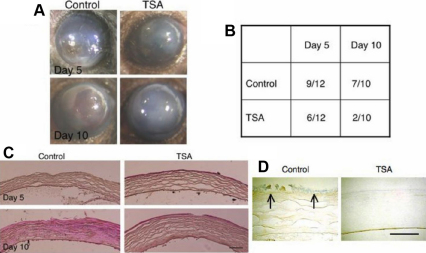Figure 5.
Evaluation of the effect of systemic Trichostatin A (TSA) on ocular surface fibrosis model of an alkali burn in mice. A: An alkali burn of the ocular surface resulted in epithelial defects, stromal scarring (opacification) and neovascularization on day 5 and day 10. Treatment of the animals with systemic TSA, i.p., seemed to reduce the incidence of residual epithelial defects and stromal opacification. B: The incidence of residual epithelial defects was significantly less ons day 10, but not on day 5, as evaluated using the χ2-square test (p<0.05). C: Histology by hematoxylin and eosin staining shows that alkali exposure induced inflammation with epithelial defects in the stroma. More cellularity, presumably due to inflammatory cells, was seen in control animals compared with that in TSA-treated mice on days 5 and 10. D: Irregular accumulation of type VI collagen α1chain was detected (arrows) in the stroma beneath the healing epithelium in a control animal, while it was not detected in the well healed epithelium of a cornea from the TSA group. Bar, 100 µm.

